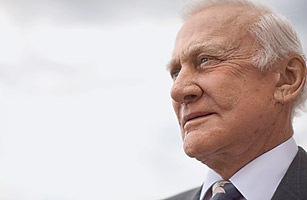
Metaphor had its way with Buzz Aldrin long before the moon did. There were always signs that the second man to set foot on the lunar surface would be stalked by demons. His grandfather fought depression for much of his life and ended his suffering only through suicide. His mother, too, struggled with melancholy and, after Aldrin's first spaceflight, in 1966, began wearing dark glasses in public to help her cope with the family's fame. In May 1968, just 14 months before Aldrin left for his lunar trip, she also took her own life. Aldrin bore the loss quietly and flew Apollo 11 flawlessly, but in case he needed his journey to carry any more portent, there was this: his mother's maiden name was Marion Moon.
I first met Buzz in 1990, years after his landmark mission and years, too, after he had overcome his own depression and alcoholism. I had not yet begun collaborating with astronaut Jim Lovell on the book Apollo 13, so Aldrin was the first lunar vet I'd ever met. We attended a dinner on the aircraft carrier Intrepid, moored on Manhattan's West Side, and I maneuvered myself so that we wound up sharing a cab east. That night, a big white platter of a moon hung over 46th Street, which seemed deeply meaningful to me but which Buzz did not seem to notice. Instead, we discussed the future of rocket propulsion and space travel, a topic that continues to fascinate him.
That future, as always, is uncertain, but as the 40th anniversary of the Apollo 11 landing arrives on July 20, the past remains familiar. Nine Apollo missions were launched moonward, and six of them landed. The cultural memories of these missions remain penny-bright — and the aging men who flew the ships retain a status that goes beyond iconic. Baseball players are icons; movie stars are icons. But those kinds of folks, we breed as we need. The lunar fraternity stopped taking members in 1972, when there were only 24 of them — and six have since died. History has produced far more American Presidents than it has lunar astronauts.
There are giants among the giants: Lovell, Shepard, Armstrong, Aldrin — figures who, like Gehrig and Lindbergh and Edison, need but one name. Others are harder for people to place: Stu Roosa, Ron Evans, Dick Gordon. But bring any one of the surviving moonmen into a room and he will be approached in the same way: with a wonder and a deference accorded to only those few who have sailed past the part of the map where dragons be and come back home to tell the rest of us what they saw.
"I'm amazed at the interest folks give to a moon walker," says Apollo 16's Charlie Duke, whose bootprints are still pressed into the moon's Descartes highlands and who, after 37 years, ought to be used to the attention. Aldrin still marvels at the seemingly universal need people have to tell him where they were on the night they watched him walk on the moon.
But what about the men themselves? What about the 39-year-old pilot who returns from the moon and knows with a mortal certainty that he has already done the most noteworthy thing he'll ever do and now must keep himself busy for the next half-century? What about the existential whiplash that comes from being on the moon one week and in your living room the next — and having to find your own way to process the vast gulf between those two worlds? "I remember coming back to Houston after the moon, and my neighbors had a barbecue for me," Dave Scott, commander of Apollo 15, told me. "I thought, 'What am I doing here?' "
And what happens when the press pack moves on, when the interviews stop and the faces of the flyers once limned with light become lined with age? "Remember where you're standing when the spotlight goes off," Lovell warned me once, when our book was a best seller and the movie it spawned was in theaters. "You'll have to find your own way off the stage."